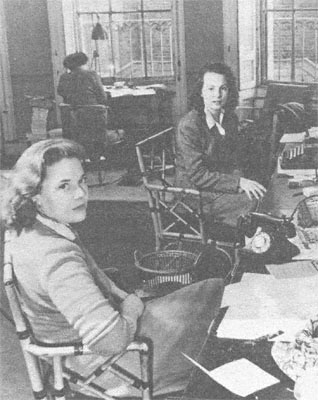The style of the photograph is perfectly iconic. We seem to be looking over Sonia Brownell’s shoulder towards Lys Lubbock, in the offices of Cyril Conolly’s magazine Horizon. It is most ironic as well, supposedly taken on the final day of publication. No paper in Lys’s typewriter and Sonia’s telephone has gone silent. Today best known as George Orwell’s widow, who collected and oversaw what the Victorians would have termed the writer’s ‘remains’, we find from D. J. Taylor’s Lost Girls: Love, War and Literature: 1939-1951 that towards the end of the magazine’s run Sonia was virtually the editor, making the editorial decisions to reject and accept, as well as reviewing the latest publications of the Paris avant garde. Having had the experience myself of editing a journal in the humanities, I know just how much an able editorial assistant contributes, in effect an editor’s alter ego. Though her formal education did not extend beyond convent school and a year at a Swiss pension, Sonia held her own in the most rarified Parisian intellectual spheres, as well as gaining the affection of a wide variety of English and American admirers, not only George Orwell, whom she married on his deathbed, but Anthony Powell, Stephen Spender, Mary McCarthy, and Jean Rhys, whose rediscovery Sonia accomplished.
One fascinating aspect of Sonia’s career seems to have escaped the credit it deserves. Before her career at Horizon, she served as the editorial assistant to Eugene Vinaver, a name little known to readers of modern literature, but instantly recognisable by every mediaeval scholar as the editor of The Works of Sir Thomas Malory. A mediaevalist recently described her: “The individual in question was Sonia Brownell (1918–80), then nineteen years old, well versed in French but untrained in Middle English palaeography, and something of a femme fatale.” And adds: “Sonia’s name is absent from Vinaver’s acknowledgements to those who helped him to transcribe Caxton’s Morte or the Winchester Manuscript.” I wonder just how much of the Oakeshott MS Sonia transcribed but given what we know of her extreme conscientiousness, I should expect she made a good job of it, especially as the MS is in a very easy and readable hand. I imagine that had Sonia been born a generation later (ie my own) she would not only have attended university, but ended up a distinguished professor of French. I suspect Vinaver’s failure to acknowledge Sonia’s assistance may owe less to any scholarly failures than that he had since become married.
I found reading this biography that Sonia Brownell was someone I’d like to have had as a friend as well as an editorial assistant, and even though glad I’d not encountered her in her later years when that might have been possible. The heavy drinking, I suspect, accompanied an introversion I found amongst many English people and with which I easily empathised, one had to be half-shot to feel comfortable amidst strangers or in a crowd, and it is easy to overdo it. Unfortunately, Sonia was also extremely averse to dealing with finances, with bad consequences for the Orwell estate for which she was unfairly blamed. As we also shared a similar traditional Roman Catholic education, I know well the steel-trap conscience that accompanies that formation. However much rationally one rejects those beliefs, the guilt continues to haunt one. I wonder if she was ever tempted to slip into the much pleasanter harbour of Anglicanism. There were lots of first-rate Anglican writers in Sonia’s time – T. S. Eliot, C. S. Lewis, Dorothy Sayers. Maybe Sonia thought the via media too easy a course, unafraid to adopt the full-scale atheism of her French contemporaries.
Yet, Sonia Brownell Orwell accomplished much more for the literature and culture of the English-speaking world than all but a few creative writers or literary scholars. First of course by preserving Orwell’s works, but also by encouraging major writers and inspiring some of their best characters, as well as discovering and commissioning new writers. Even though I never met her, I feel I’ve discovered a friend and inspiration.

How wonderful to find a friend in the past like this!
LikeLike